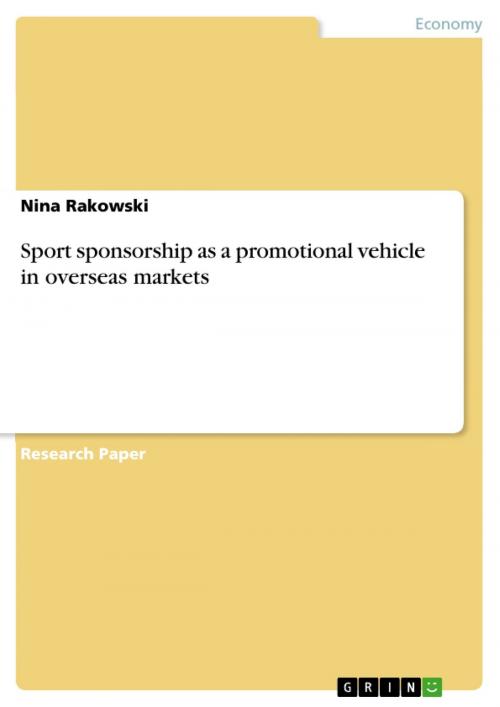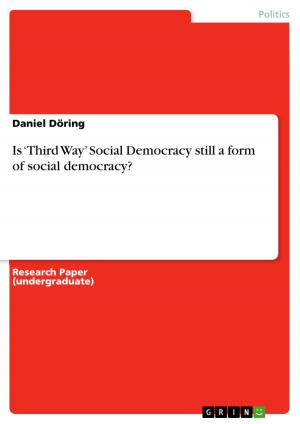Sport sponsorship as a promotional vehicle in overseas markets
Business & Finance, Marketing & Sales| Author: | Nina Rakowski | ISBN: | 9783640200450 |
| Publisher: | GRIN Publishing | Publication: | November 5, 2008 |
| Imprint: | GRIN Publishing | Language: | English |
| Author: | Nina Rakowski |
| ISBN: | 9783640200450 |
| Publisher: | GRIN Publishing |
| Publication: | November 5, 2008 |
| Imprint: | GRIN Publishing |
| Language: | English |
Research Paper (postgraduate) from the year 2008 in the subject Business economics - Marketing, Corporate Communication, CRM, Market Research, Social Media, grade: 70 %, University of Western Sydney (University of Western Sydney), course: Promotion & Advertising Overseas, 0 entries in the bibliography, language: English, abstract: In the past ten years the Australian sports sponsorship industry has seen significant changes. The Olympic Games in Sydney in 2000 have been the sport sponsorship entry for a lot of Australian companies. Australians have a very high interest in sports. Sweeney Sports Research found that somewhere between 98% and 99 % of 16-65 years of age Australians are interested in sport. By interest they defined that people participated personally in sports, watched it on television as much as possible, listen to the radio as much as possible or read about sports in newspapers on a regular basis (Hirons, 2002). This is the reason why sport in Australia can be seen in all traditional media such as print, television, magazines, radio, newspapers but also in new media such as the internet. According to Hirons, in 2000 a lot of sponsorship agreements expired naturally and since then organisations have changed their strategies in many ways. As an example, Uncle Tobys decided to withdraw from Iron/Ocean Man. Kellogg now makes a lot of sponsoring of lifesaving and invests more and more in community based initiatives. Ford withdrew from the tennis sponsorship and was replaced by Kia. Holden and Ford invested heavily in motor sport. Fosters lost the Melbourne Cup which is now sponsored by Tooheys. Additionally, the stadium sponsorship trend is increasing more and more as companies try to avoid the cluttered sponsorship market. Stadiums nowadays have names such as Telstra, Vodafone, AAMI, etc (Hirons, 2002). The sponsorship market continues to grow. The current dollar value estimates in Australia put the market at around AUS $1.6 billion whereas the global sponsorship spend is worth AUS $36 billion (IEG, 2003, 2005) (S-Comm, 2006). In the following chapters the author presents an overview of sport sponsorship, gives a detailed analysis of what a company needs to consider, the issues related to sponsorship and how to minimize them. Examples will be given in order to link theoretical background with practical examples to achieve a level of full understanding for the reader.
Research Paper (postgraduate) from the year 2008 in the subject Business economics - Marketing, Corporate Communication, CRM, Market Research, Social Media, grade: 70 %, University of Western Sydney (University of Western Sydney), course: Promotion & Advertising Overseas, 0 entries in the bibliography, language: English, abstract: In the past ten years the Australian sports sponsorship industry has seen significant changes. The Olympic Games in Sydney in 2000 have been the sport sponsorship entry for a lot of Australian companies. Australians have a very high interest in sports. Sweeney Sports Research found that somewhere between 98% and 99 % of 16-65 years of age Australians are interested in sport. By interest they defined that people participated personally in sports, watched it on television as much as possible, listen to the radio as much as possible or read about sports in newspapers on a regular basis (Hirons, 2002). This is the reason why sport in Australia can be seen in all traditional media such as print, television, magazines, radio, newspapers but also in new media such as the internet. According to Hirons, in 2000 a lot of sponsorship agreements expired naturally and since then organisations have changed their strategies in many ways. As an example, Uncle Tobys decided to withdraw from Iron/Ocean Man. Kellogg now makes a lot of sponsoring of lifesaving and invests more and more in community based initiatives. Ford withdrew from the tennis sponsorship and was replaced by Kia. Holden and Ford invested heavily in motor sport. Fosters lost the Melbourne Cup which is now sponsored by Tooheys. Additionally, the stadium sponsorship trend is increasing more and more as companies try to avoid the cluttered sponsorship market. Stadiums nowadays have names such as Telstra, Vodafone, AAMI, etc (Hirons, 2002). The sponsorship market continues to grow. The current dollar value estimates in Australia put the market at around AUS $1.6 billion whereas the global sponsorship spend is worth AUS $36 billion (IEG, 2003, 2005) (S-Comm, 2006). In the following chapters the author presents an overview of sport sponsorship, gives a detailed analysis of what a company needs to consider, the issues related to sponsorship and how to minimize them. Examples will be given in order to link theoretical background with practical examples to achieve a level of full understanding for the reader.















